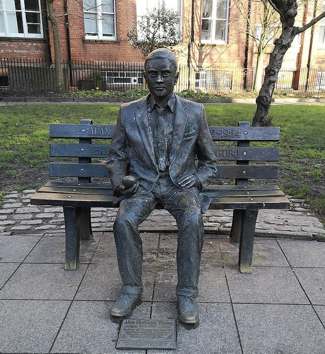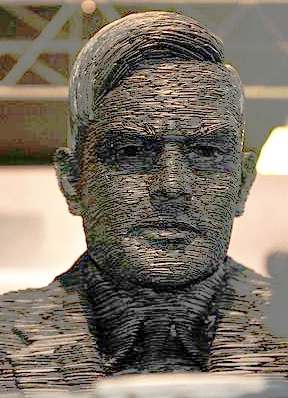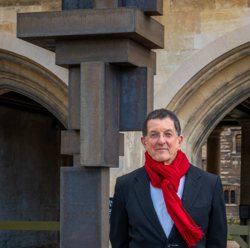| Alan Turing Commemorated In Steel |
| Written by Sue Gee | |||
| Sunday, 28 January 2024 | |||
|
A steel sculpture commemorating Alan Turing has been erected in the grounds of King’s College, Cambridge where Turing studied mathematics as an undergraduate and was a Fellow between 1935 and 1952. The extraordinary artwork, titled True, for Alan Turing, is by Sir Antony Gormley, who studied Art at Trinity College, Cambridge. Commissioned by King's as a "visible recognition of the life and achievements of Alan Turing" the twelve-foot high sculpture is an abstract figure made 140 mm thick rolled Corten steel, designed to turn a warm rust colour over time. According to Gormley the sculpture’s relationship with time and weather is an integral part of its character. Initially, objections were made by Historic England to the proposal on the grounds that it: "would harm the particular character created by the interplay of buildings and landscape, which makes the college so remarkable a place” However, in light of numerous letters of support from key art world figures, in 2022 Cambridge City Council took the decision to go ahead. This was welcomed by Kings College which intended that the memorial would encourage members of the public and young people to enjoy this major work of art and to reflect on the life of Alan Turing, the appalling treatment he faced as a result of his sexuality, and the role his work has played in shaping the modern world. At the time, the Provost of King’s, Professor Michael Proctor, commented: From the papers he published at Cambridge which are now recognised as the foundation of computer science, through his vital code-breaking work at Bletchley Park during the Second World War which is credited with the saving of countless lives, to his exploration of the idea of artificial intelligence, the importance of Alan Turing and his impact on our world are hard to overestimate. It was in the College’s tolerant, open-minded and intellectual environment that Turing was able to live a fulfilled life both as a homosexual man and an abstract thinker, and we are enormously proud to acknowledge the significance of his unparalleled contribution to science and modern computing in this way. We hope the sculpture will be a great source of interest and pleasure to many. Speaking at the recent unveiling, the current Provost, Dr Gillian Tett said: Antony Gormley’s sculpture is designed to reflect both Turing’s brilliance and his vulnerability, but at the same time the sculpture also embodies the transformation of the industrial into the information age. Alan Turing played a crucial part in this transformation, one that continues to reshape our world today. and Gormley said: “Alan Turing unlocked the door between the industrial and the information ages. I wanted to make the best sculpture I could to honour a man who was pivotal in changing the course of all our lives. It is not about the memorialisation of a death, but about a celebration of the opportunities that a life allowed.” Two previous sculptures of Turing are representational and show him sitting. The earlier, unveiled in 2001, is in Sackville Gardens, Manchester between the university science buildings where he worked during the later years of his life and the gay bars where he was thought to have spent his evenings. In bronze by sculptor Glynn Hughes it has a life sized figure seated on a Park Bench holding an apple, a reference to the idea that Turing ate an apple laced with cyanide to take his own life. The later one, again life-sized, is located at Bletchley Park and was unveiled in 2007 to honor Alan Turing as a codebreaker. Made in slate by Stephen Kettle, it depicts him sitting at a desk looking at an Enigma machine, and is comprised of approximately half a million individual pieces of Welsh slate from Llechweddand in North Wales where Turing used to holiday as a child. It is described as bearing "a faultless resemblance" to Turing and was part of Bletchley Park's 2012 Centenary Exhibition marking 100 years since Turing's birth. Alan Turing's portrait is still in circulation as it is now depicted on the UK's £50 note which also has references to many aspects of his life, work and genius.
King's College Cambridge created and maintains the Turing Digital Archive and in recent years King’s has honoured Turing’s legacy in a number of ways. An annual Alan Turing Lecture brings experts from across the world to discuss themes relevant to Turing, and the College Library and Archives teams have created exhibitions about both Turing’s life and work, showcasing the College’s extensive collection of Turing papers, photographs and artefacts. In 2017 the College launched the Alan Turing Initiative to support scholars in computer science and mathematics, as well as in the history and politics of gender and sexuality. The college alreasy hosts one philanthropically funded Alan Turing MPhil student in advanced computer science each year (the TPP Alan Turing Scholar), and three Alan Turing PhD students (the Enactor Alan Turing PhD Programme), working on research topics across computer science and applied mathematics and theoretical physics. These are now part of the Alan Turing Programme at King's. To accompany True, for Alan Turing there's a new website about the sculputure, its subject and its sculptor which is an excellent additional resource for the life and legacy of Alan Turning. A quote from the website give's the last word to Antony Gormley: “I want this work to be something that the life of the college lives with and that will be a continual source of questioning, of projection, a marker of an elusive relationship to a person and our evolving time.”
More InformationAlan Turing Programme at King's Related ArticlesTo be informed about new articles on I Programmer, sign up for our weekly newsletter, subscribe to the RSS feed and follow us on Twitter, Facebook or Linkedin.
Comments
or email your comment to: comments@i-programmer.info |
|||
| Last Updated ( Monday, 29 January 2024 ) |






